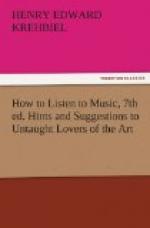[Sidenote: Lines of choral culture in the United States.]
The lines on which choral culture has proceeded in the United States are two, of which the more valuable, from an artistic point of view, is that of the oratorio, which went out from New England. The other originated in the German cultivation of the Maennergesang, the importance of which is felt more in the extent of the culture, prompted as it is largely by social considerations, than in the music sung, which is of necessity of a lower grade than that composed for mixed voices. It is chiefly in the impulse which German Maennergesang carried into all the corners of the land, and especially the impetus which the festivals of the German singers gave to the sections in which they have been held for half a century, that this form of culture is interesting.
[Sidenote: Church and oratorio.]
[Sidenote: Secular choirs.]
The cultivation of oratorio music sprang naturally from the Church, and though it is now chiefly in the hands of secular societies, the biblical origin of the vast majority of the texts used in the works which are performed, and more especially the regular performances of Handel’s “Messiah” in the Christmastide, have left the notion, more or less distinct, in the public mind, that oratorios are religious functions. Nevertheless (or perhaps because of this fact) the most successful choral concerts in the United States are those given by oratorio societies. The cultivation of choral music which is secular in character is chiefly in the hands of small organizations, whose concerts are of a semi-private nature and are enjoyed by the associate members and invited guests. This circumstance is deserving of notice as a characteristic feature of choral music in America, though it has no particular bearing upon this study, which must concern itself with choral organizations, choral music, and choral performances in general.
[Sidenote: Amateur choirs originated in the United States.]
[Sidenote: The size of old choirs.]
Organizations of the kind in view differ from instrumental in being composed of amateurs; and amateur choir-singing is no older anywhere than in the United States. Two centuries ago and more the singing of catches and glees was a common amusement among the gentler classes in England, but the performances of the larger forms of choral music were in the hands of professional choristers who were connected with churches, theatres, schools, and other public institutions. Naturally, then, the choral bodies were small. Choirs of hundreds and thousands, such as take part in the festivals of to-day, are a product of a later time.
[Sidenote: Handel’s choirs.]




